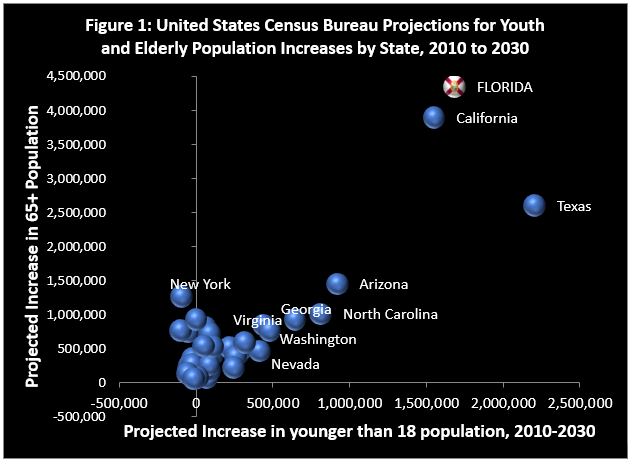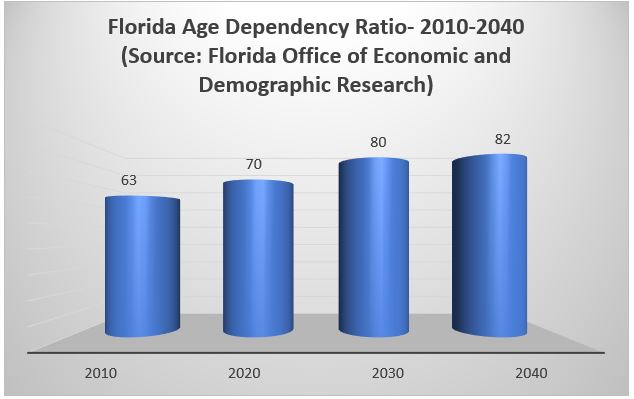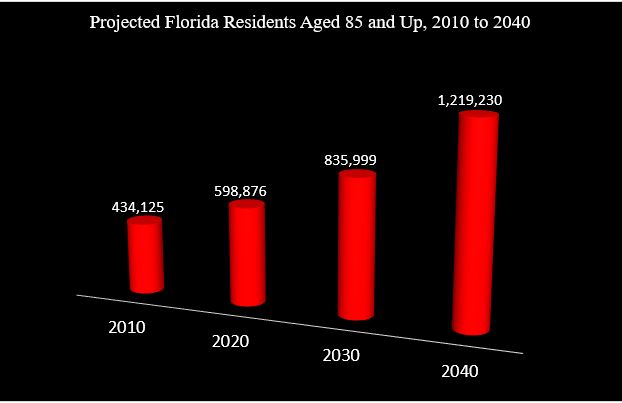A few years back I visited these pages to discuss Florida’s age demographic change, and the challenges it will pose to policymakers, especially with regards to health care and education. Here’s the abridged version: Florida has lots of elderly people, and lots of young people, and relatively few working-age people paying for health care for the elderly and education for the young. This should not be terribly shocking if you have walked around a bit in Florida. The problem: demographers project Florida is growing large additional populations of elderly and young people. When you use Census projections to plot out all 50 states, it looks like: The Census Bureau made these projections some time ago and decided to leave the task of updating projections to the state. Fortunately, Florida’s Office of Economic and Demographic Research (EDR) has created updated age demography projections for the state. There’s good news and there’s bad news in the updated EDR projections. The good news: They aren’t as scary as the Census projections. The bad news: It’s not by much.
The Census Bureau made these projections some time ago and decided to leave the task of updating projections to the state. Fortunately, Florida’s Office of Economic and Demographic Research (EDR) has created updated age demography projections for the state. There’s good news and there’s bad news in the updated EDR projections. The good news: They aren’t as scary as the Census projections. The bad news: It’s not by much.
Demographers calculate an “age dependency ratio” as a measure of societal strain. To create an age dependency ratio, you take the under-18 population, add in the 65-and-older population, and then divide that sum by the number of 18- to 64-year-old people. Basically, what you are looking at is the ratio of people less likely to be in the workforce and more likely to be drawing on state services like K-12 education and Medicaid to those more likely to be in the workforce (and thus carrying the bulk of the burden for paying for things like education and health care services).
Here are the age dependency ratios for Florida in 2010, 2020, 2030 and 2040 based on EDR projections. Think of it this way: For every 100 working-age people pushing the cart of Florida’s social welfare state, how many elderly and young people do you have riding in the cart?
 Four years from the time of this writing will mark the half-way mark for the massive Baby Boom generation reaching the age of 65. By 2030, all surviving Baby Boomers will have reached the age of 65. From a state budget perspective this is challenging on multiple fronts: retirees live on fixed incomes and have left their peak earning and taxpaying years behind. They also draw upon state health care benefits at a rate far above average.
Four years from the time of this writing will mark the half-way mark for the massive Baby Boom generation reaching the age of 65. By 2030, all surviving Baby Boomers will have reached the age of 65. From a state budget perspective this is challenging on multiple fronts: retirees live on fixed incomes and have left their peak earning and taxpaying years behind. They also draw upon state health care benefits at a rate far above average.
States like Florida and Arizona have an added wrinkle as retirement destinations. Incoming retirees provide a short-term economic boon to a state economy as they make some major purchases (like condos) but then they often live frugally. The state budgetary gain turns to pain with the “super elderly” aged 85+ who tend to draw mightily on state health care spending late in life. Below are the EDR projections for Florida residents age 85 and over.
 Using 2010 as the baseline for comparison, that looks like an almost doubling by 2030 and a getting close to tripling by 2040. A fierce battle over limited state resources may loom: a generational battle between the old and the young, education spending versus health care spending.
Using 2010 as the baseline for comparison, that looks like an almost doubling by 2030 and a getting close to tripling by 2040. A fierce battle over limited state resources may loom: a generational battle between the old and the young, education spending versus health care spending.
We should all – left, right and center – seek to avoid such a clash. By far the best solution involves Florida developing a far more productive and innovative workforce to accompany far-reaching policy and medical innovations. Florida K-12 spending is enshrined in the state constitution and won’t be going anywhere, but the need to develop methods to better educate student at the same or lower costs will grow increasingly acute.
Absent substantial productivity/policy/medical innovation:

Many of the Florida taxpayers who will be tasked with paying for the pensions and health care expenses of the Baby Boom retirees of 2020, 2030 and 2040 sit in Florida’s classrooms right about now. Fortunately, there has been an enormous amount of progress made over the last two decades in Florida education, the subject of a forthcoming post.


